Brief History and Guide to Cannabis Pipes
Since the legalization of cannabis in most states, cannabis pipes are more popular than ever, coming in an abundance of different styles and material, which can be overwhelming for first-time consumers. To help, this article will briefly the history of cannabis pipes and a description of the different types, including what they’re made of and their relative pros and cons.
Brief History
The oldest known cannabis smoking pipe dates back to 1320 AD. In the 1970s, archeologists working in Africa discovered two ceramic pipes in the Lalibela Cave in Ethiopia. The pipes contained small traces of black resin that proved to be cannabis. These pipes were similar to bongs discovered in Russia dating back to 1000 A.D., which also contained traces of cannabis resin. Prior to glass, these early pipes were made of clay, stone, or wood. It wasn’t until the 1960s that glass pipes came onto the scene, with the first glass pipe patented in 1977.
In 2003, the federal government cracked down on the glass pipe industry when it spent around $12 million and shut down 55 retailers for selling “drug paraphernalia.” Consequently, multiple online “headshop” stores were removed from the web. However, since the legalization movement, headshops (and the pipes they sell) are more prevalent and popular then ever before.
Pipe Material
Today, cannabis pipes typically are made of glass, metal, wood, ceramic, or more recently, silicone. Each type has their own advantages and disadvantages.
Glass
Glass pipes, which are probably the most popular, produce a very clean, full-body hit. Of all the types, glass pipes retain the flavor of the cannabis best. However, being made of glass, they’re also the most delicate and prone to breaking.
Metal
Being made of metal, these pipes are the most durable and won’t break if dropped like glass pipes. In addition, they’re easier to clean and take apart and also tend to be smaller, thus easier to conceal. On the downside, metal pipes can get really hot and create a metallic taste in your mouth.
Wood
Next to ceramic, wooden pipes are one of the oldest forms of pipes. While typically used for tobacco, wooden pipes can be used for smoking cannabis as well. Wooden pipes can change the taste and flavor of the cannabis depending on the type of wood. Like metal pipes, wood pipes are virtually indestructible, but are harder to keep clean.
Ceramic
As previously mentioned, ceramic pipes are the oldest known type of cannabis pipe. Ceramic pipes tend to be cheaper and long-lasting. In addition, ceramic pipes retain heat well but won’t burn you, unlike metal pipes. Although not as fragile as glass, ceramic pipes may break if dropped.
Silicone
Finally, silicone pipes have become more popular recently. The biggest advantage of silicone pipes is that they’re basically indestructible. In addition, they can be folded up to be more hidden and discrete. However, silicone pipes can also create an unpleasant taste in your mouth when using.
Pipe Styles
Besides the material they’re made of, pipes come in a variety of styles, shapes and sizes.
Spoons
Spoon pipes are probably the most common style of pipe. As the name implies, they have a spoon-like shape with a bowl for the cannabis, a carb hole, a mouthpiece, and neck. These pipes are typically made of glass, but can also be metal. Being small, spoon pipes can be hidden and carried easy, but if made of glass, it can break easily if dropped. In addition, these pipes are easy to clean.
One-hitters
One-hitters are small hand-held cylindrical tube-shaped pipes made of various materials (glass, metal or wood). They often resemble a cigarette and come with a pocket-size case to carry it in called a “dugout”. In addition to being very discreet, one-hitters (unlike a joint) will go out on its own after a hit or two, so it won’t continue to burn.
ADVERTISMENT
Chilliums
Chilliums are small hand pipes typically made of glass, wood, or clay. Like one-hitters, they are cylindrically shaped with a bowl for the cannabis on one end and the mouthpiece on the other. Like the spoon pipes, chilliums are great for portability, but provide a stronger direct hit, so chilliums might be preferred by regular smokers.
Water Pipes (Bongs & Bubblers)
There are two different basic types of water pipes—bongs and bubblers. The main difference between the two being size. Both use water to cool the smoke, making for a much smoother hit, but bongs are much larger, offering bigger more flavorful hits, but is less portability than a bubbler, which is essentially a smaller version of a bong. Water pipes are usually made of glass, but also come in silicone.
Vaporizer Pipes
Finally, vaporizer pipes (often called “vapes”) have become very popular over the past few years. Unlike regular pipes, vapes use electricity to heat the cannabis. Consequently, it allows you to get the maximum amount of THC without all the smoke. However, vapes are much more expensive and harder to clean than most regular pipes. In addition, for some users vaping just isn’t as enjoyable or rewardable as smoking cannabis.


